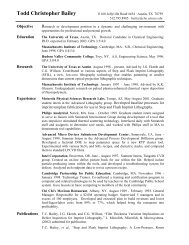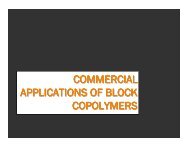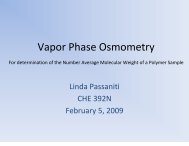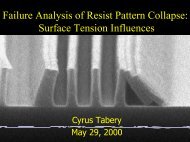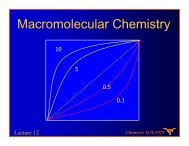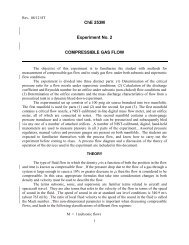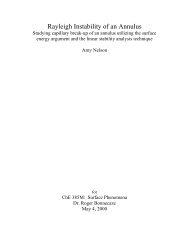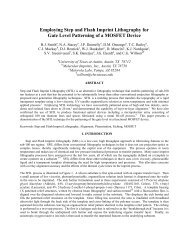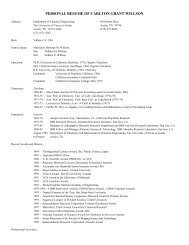Asymmetric fluid-structure dynamics in nanoscale imprint lithography
Asymmetric fluid-structure dynamics in nanoscale imprint lithography
Asymmetric fluid-structure dynamics in nanoscale imprint lithography
- No tags were found...
You also want an ePaper? Increase the reach of your titles
YUMPU automatically turns print PDFs into web optimized ePapers that Google loves.
the composite stiffness was calibrated us<strong>in</strong>g the results from one experimentaldata set (known as the calibration set). The calibrated composite stiffness wasused to perform simulations that were then correlated to an <strong>in</strong>dependent set ofexperimental results (known as the correlation set). From the simulation results,it is <strong>in</strong>ferred that the actual composite stiffness was less than previouslyestimated. A comparison of the correlation set and the simulation supports thehypothesis. The data show similar trends and are reasonably close. However,there are still discrepancies, especially at large times, which may be due toparticles and other unknown parameters that have not been calibrated. Theseissues require further <strong>in</strong>vestigation. The follow<strong>in</strong>g details the process used <strong>in</strong>calibrat<strong>in</strong>g the composite stiffness parameter.A calibration simulation was performed tak<strong>in</strong>g <strong>in</strong>itial conditions thatapproximate the conditions for a specific set of measured data. With the fiberoptic spectrometer probes spaced 0.7 <strong>in</strong>ches apart, the measured gap thickness foreach probe was 4780 nm and 2360 nm and the probe locations are assumed to besymmetric about the center of rotation of the template hold<strong>in</strong>g mechanism. Thisleads to an average height of 3570 nm with θ ~ 1.36 × 10 -4 radians and totalactuation of 5 µm. These <strong>in</strong>itial conditions were used to perform a simulation ofthe squeeze film <strong>dynamics</strong> of the active stage system.The composite axial stiffness and damp<strong>in</strong>g were systematically decreaseduntil the agreement between the film thickness from the experiments and thesimulations were with<strong>in</strong> five percent. The axial stiffness was 1.5 × 10 6 N/m andthe damp<strong>in</strong>g constant was 75 N⋅s/m. The rema<strong>in</strong><strong>in</strong>g system parameters <strong>in</strong> thenumerical simulation were taken from table 5.2. Figure 6.4 shows the data setused <strong>in</strong> the calibration of the composite stiffness. The simulated film thicknessand the experimentally obta<strong>in</strong>ed film thickness values are with<strong>in</strong> two percent.85



